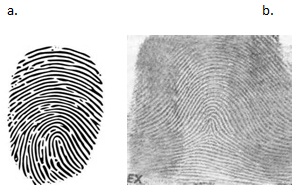Assignment:
Some of the evidence from the Fitchburg crime scene (case scenario part I) has been taken to the State Police Crime Laboratory. Please answer the following questions with regard to the evidence below.
1. Identify the major fingerprint pattern and one minutiae for the two prints below.

2. Jim Jones has a fingerprint record with a WWWAWWAWWA pattern series. Calculate the Henry classification ratio for this print. Please show your work.
3. Latent prints are found on the glass bottle recovered in the bedroom of Jane Towney.
a. What techniques might be used to make the fingerprints sufficiently visible for subsequent comparison and identification?
b. The glass bottle as shown in module 1, is dark in color. What photographic techniques could be used to make the dark fingerprint be made more visible?
c. How would ACE-V and AFIS be used in the identification process?
4. The roll of bills found at the scene was analyzed. Several of the bills were 2010 $100 bills. How might the border, serial numbers, and paper be used to determine if the bill is counterfeit? (Refer to the document "Know your "Money" posted under this week's module resources.
5. Under the bedding in the room, three fired bullets were found.
a. Provide three types of information that could be gathered from bullets to assist in determining the type of firearm that discharged the bullet.
b. What type of microscope is used for analysis of the casings?
c. What database is employed by police departments for analyzing shell casings?
6. The following questions are based on the videos below biometrics and Biometrics Standards
a. What is DoD ABIS?
b. What is NIST and what is its purpose?
c. Why is interoperability important in biometrics?
d. Explain MBARK in a short paragraph or 4 to 5 sentences.